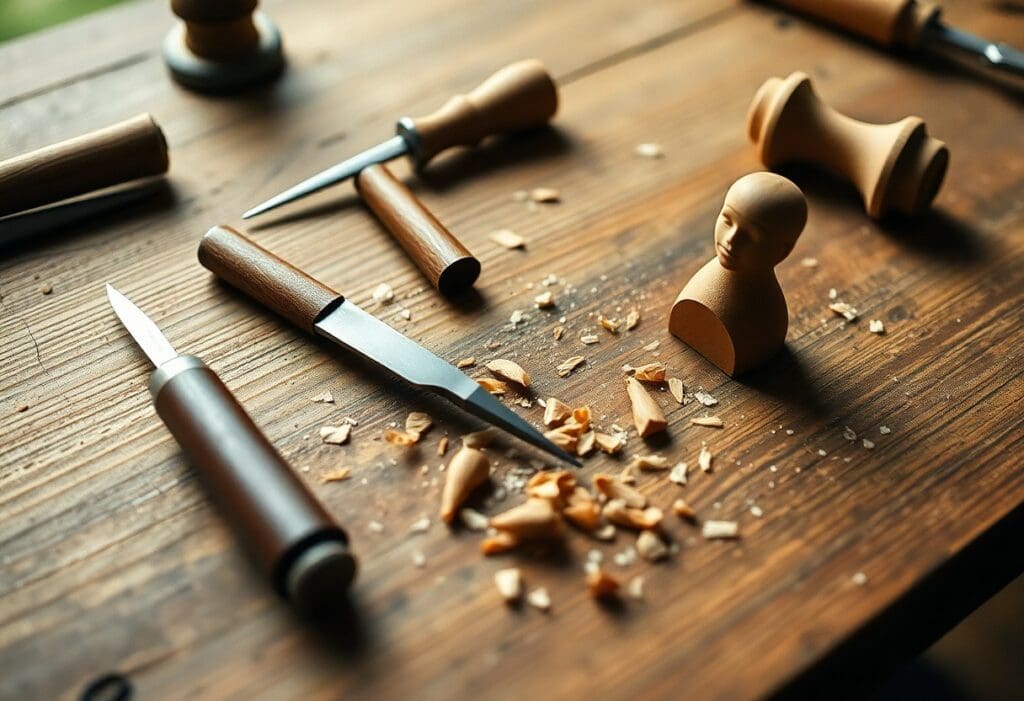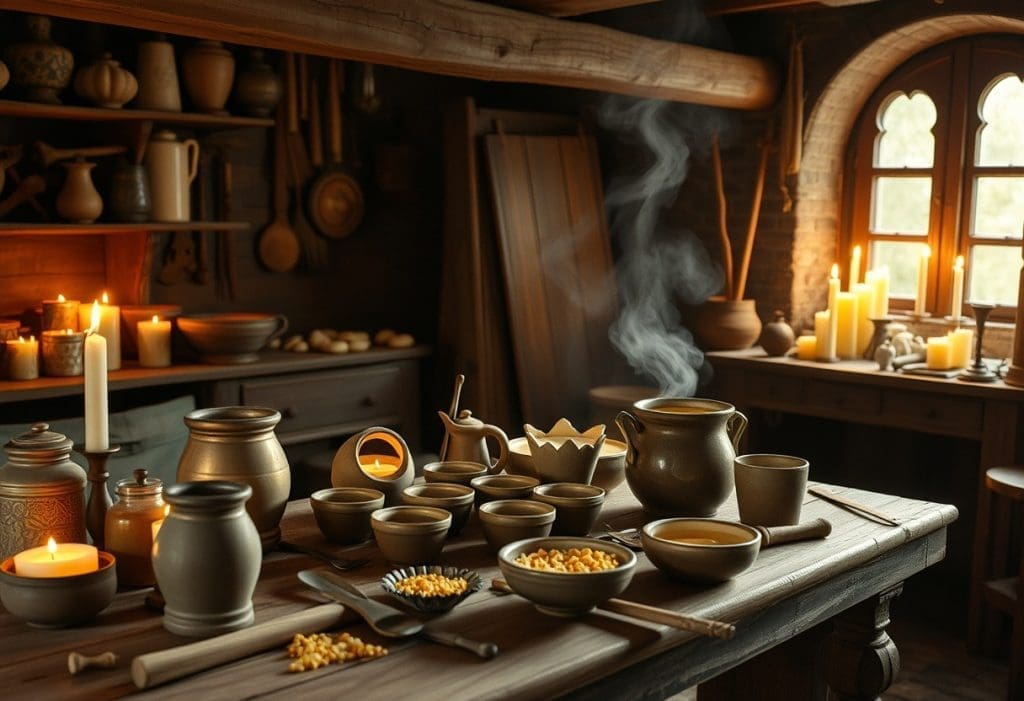Over the years, whittling and wood carving have become cherished crafts that allow you to express your creativity while honing your skills.
Whether you’re a beginner eager to learn the basics or an experienced carver looking for new inspiration, this guide will provide you with necessary tips, tools, and techniques to help you get started on your woodwork journey.
You’ll discover how to choose the right materials and develop your unique style in this rewarding pastime.
The Allure of Wood: A Material Like No Other
The Unique Properties of Wood
Wood boasts a charm that’s unmatched by synthetic materials. Each type has its own grain pattern, color variation, and texture, which opens endless possibilities for your projects.
Its inherent warmth makes it inviting to touch and visually appealing.
Plus, the versatility of wood allows for easy manipulation; whether you’re carving a delicate figure or crafting a sturdy piece of furniture, wood responds beautifully to your tools.
The Sustainable Appeal and Environmental Impact
Choosing wood for your projects not only adds character but aligns with environmental stewardship.
As a renewable resource, sustainably sourced wood has a lower carbon footprint compared to plastic or metal alternatives.
Trees absorb carbon dioxide as they grow, playing a crucial role in combating climate change.
The act of creating with wood empowers you to connect with nature while promoting ecological balance.
Supporting sustainable forestry practices means you contribute to a system that nurtures our planet.
When you select wood certified by organizations like the Forest Stewardship Council (FSC), you help ensure that forests remain intact for future generations.
Engaging in wood crafting not only allows you to create unique pieces but also spreads awareness about environmental conservation and supports local economies that depend on sustainable timber production.
Essential Tools of the Trade
Must-Have Whittling Tools for Beginners
Starting your whittling journey doesn’t require an extensive toolkit; a few important tools will set you on the right path.
A basic whittling knife, preferably a fixed-blade option, is ideal for carving simple shapes.
Complement this with a small set of carving knives which can tackle detail work and achieve smoother finishes.
Additionally, a good-quality saw, like a coping saw, is handy for cutting pieces of wood into manageable sizes.
Investing in a few wood carving chisels can also expand your creative possibilities.
Advanced Tools for Serious Carvers
As you progress in your craft, you might find specific tools that cater to more advanced techniques.
Dedicated wood carving sets equipped with a variety of specialized knives and chisels will allow for intricate designs and texture work.
Power tools, like rotary tools or chiseling machines, can also enhance your efficiency, making more complex tasks easier.
Transitioning to these additional tools will help you tackle projects that require higher precision and detail.
Advanced Tools for Serious Carvers
| Tool | Purpose |
| Detail Knife | For fine detailing and intricate designs |
| Chip Carving Knife | Great for creating geometric patterns |
| Power Carving Tools | For faster removal of material and detailed work |
| Carving Gouges | Used for making curved cuts and adding texture |
Advanced carving tools open up a world of creativity and precision. For instance, a detail knife allows you to carve fine lines and delicately textured areas that would otherwise be challenging with basic tools.
Rotary power tools can quickly shape wood and bring your designs to life, making them a favorite among experienced carvers.
Specialized gouges can create concave shapes that are vital for adding depth and dimension, allowing you to really explore the artistic side of wood carving.
Proper Tool Care and Maintenance
Taking care of your tools ensures longevity and consistent performance.
Regularly sharpening your knives and chisels will keep them effective and safe to use. This process often requires a whetstone or a specialized sharpening tool, depending on the blade’s angle.
Additionally, wiping your tools clean after each use helps prevent rust and wear, while storing them in a dry place preserves their quality.
Maintaining your tools is simple but important. Frequent sharpening not only keeps the tools performing well but also contributes to your safety by reducing the chances of slips or accidents.
Taking a few moments to clean and dry your knives after use removes moisture that can lead to corrosion.
Consider investing in protective sheaths or storage boxes to keep your tools organized and prevent damage.
These small maintenance routines can significantly enhance your carving experience.
Whittling Techniques That Captivate
Mastering the Basics: Safety and Grip
Before exploring into whittling, establishing a safe work environment and proper grip is crucial.
Use a sharp knife designed for whittling, and always cut away from your body.
Ensure your workpiece is securely held, either by hand or in a clamp.
A comfortable grip on the knife will allow for better control and precision, making your whittling experience not just safer but also more enjoyable.
Essential Cuts Every Beginner Should Know
Understanding the fundamental cuts in whittling sets the groundwork for any project.
The basic cuts include the straight cut, the push cut, and the pull cut, each serving a different purpose and allowing you to create intricate designs.
These techniques are crucial building blocks in your toolkit and will be applicable in a variety of whittling projects.
The straight cut forms the basis of most designs, enabling you to make clean, consistent slices through the wood.
The push cut offers precision in shaping areas, allowing for detailed work, while the pull cut is great for rounding edges or shaping curves.
These foundational techniques can open up a world of possibilities, empowering you to tackle more complex designs as you gain experience.
Innovations in Whittling Techniques
The art of whittling is not static; it continuously evolves.
Advanced techniques, tools, and materials have emerged, enhancing both the creativity and efficiency of this craft.
From specialized knives to digital templates, embracing innovation can transform your whittling experience and expand the range of your artistic expression.
Today’s whittlers can explore options like electric carving tools and laser-cut templates, allowing for greater precision and intricate designs that were once labor-intensive.
Moreover, techniques inspired by other crafts, such as chip carving or relief carving, offer fresh avenues to explore.
By combining traditional practices with new innovations, you can streamline your workflow and create pieces that are both unique and impressive.
From Block to Art: Bringing Your Vision to Life
Choosing Your Project: Simple to Complex
Start your journey by selecting a project that matches your skill level.
Beginners can opt for simple items like a spoon or a small animal figurine, while those with more experience might tackle intricate designs such as decorative masks or detailed sculptures.
Be realistic about what you can handle; a project that aligns with your abilities will keep you motivated and allow for a more enjoyable carving experience.
Planning Your Design: Sketching and Outlining
Before you start carving, sketching your design is imperative to visualize the final piece.
Create outlines that define shapes and details, ensuring that your vision is clear and achievable during the carving process.
This preparation can save you time on revisions and help avoid potential mistakes as your project unfolds.
Sketching doesn’t have to be elaborate; stick figures or simple shapes can effectively convey your ideas.
Use pencil and paper for quick adjustments, allowing you the freedom to explore different angles and proportions.
Once happy with your sketches, outline them on the wood block using a light pencil, so you have guidelines to follow as you carve.
This thoughtful approach leads to more satisfying results and can elevate the overall quality of your work.
Achieving Detail: Adding Intricacies to Your Work
As you progress, focus on the finer aspects of your carving. If you embrace small details like texture, contours, and embellishments, you can transform a basic shape into a refined piece of art.
Develop your technique gradually, starting with broader strokes before moving into intricate carvings that demand precision.
Adding details can completely change the character of your work. Carving tiny grooves or delicate patterns creates depth and realism, which captivates viewers.
Use specialized tools, such as micro blades or chisels, designed for fine work to achieve these intricacies.
Practice makes perfect; over time, your confidence with these tools will grow, allowing you to push the boundaries of your creativity and craftsmanship.
Embrace the process and enjoy the journey of bringing your artistic vision to life.
The Craft of Wood Carving: Unleashing Creativity
The Progression from Whittling to Carving
Transitioning from whittling to carving marks an exciting evolution in your woodworking journey.
While whittling often involves simple cuts and the creation of small objects, carving provides an avenue for more intricate designs that can be both functional and artistic.
As your skills develop, you’ll find yourself experimenting with different tools and techniques, elevating your craftsmanship to new heights.
Exploring Different Styles and Their Origins
Wood carving comes in a variety of styles, each with its unique characteristics and cultural significance.
You may encounter traditional styles like chip carving, which originates from Europe, or the bold lines of American folk art, reflecting the diverse influences that shape this craft.
When you understand these styles, it will not only enrich your appreciation but also inspire your own creative process.
Chip carving, for instance, emerged in the 18th century and focuses on geometric patterns using a whittling knife. Meanwhile, Scandinavian courting arts often feature romantic motifs carved into wooden items.
Native American carving showcases intricate totem designs that tell stories of history and beliefs. By exploring different styles, you can adopt techniques and motifs that resonate with your artistic vision and heritage.
Carving for Function vs. Carving for Aesthetic
Functionality and aesthetics often guide your carving choices, each serving distinct purposes.
Functional carvings can include spoons, bowls, or furniture, emphasizing usability.
On the other hand, aesthetic carvings focus on visual appeal, showcasing artistic expression without necessarily having a practical use.
An understanding of both can enhance your versatility as a woodworker.
Common Pitfalls in Whittling and Carving
Three Mistakes Most Beginners Make
As you start your whittling or wood carving journey, it’s common to fall into a few traps.
Many beginners tend to choose hard woods instead of softer, easier materials, which can lead to frustration and discouragement.
Another mistake is underestimating the importance of proper tools, often opting for inexpensive options that lack quality.
Lastly, inadequate planning and sketching of designs can lead to unexpected challenges during the carving process.
Learning from the Errors: Tips for Improvement
Embracing your mistakes is vital for growth in whittling and carving.
Start by analyzing your past projects to pinpoint what went wrong.
You can improve by adjusting your material choice to softer woods, investing in better tools, and sketching designs before starting.
With practice, you’ll learn techniques that enhance your skills and confidence.
- Feel free to experiment with different types of wood.
- Invest in reliable tools suited for your level.
- Sketch and plan your projects to avoid errors.
After careful evaluation, make a habit of refining your approach each time you carve.
Join a local wood carving group or online forum where you can share your experiences and gain insights from fellow enthusiasts.
Seek feedback. It can open your eyes to new techniques and tricks that can elevate your craft.
Consider documenting your progress to track your improvements and hold onto your best ideas for future projects.
- Keep a journal of your carving techniques and designs.
- Solicit constructive criticism from more experienced carvers.
- Practice patience; each project is a learning opportunity.
With carving, it’s easy to feel overwhelmed when your first projects don’t meet your expectations.
Developing patience is vital as you master the intricacies of your craft.
Each piece you create teaches you more about shape, form, and technique, allowing you to build upon your skills with time.
Next time you find yourself feeling frustrated, take a break and revisit your passion.
Remember that patience leads to finesse; even the most seasoned artists had to face challenges and setbacks along the way.
Embrace the journey, knowing that perseverance will yield rewarding results.
Engage with the creative process, and slowly but surely, you’ll find yourself improving with each whittle of the knife.
The Whittling Community: Finding Your Tribe
Online Platforms and Resources for Whittlers
Online communities abound for whittlers seeking connection, inspiration, and guidance.
Platforms like Reddit, Facebook groups, and specialized forums provide spaces for discussing techniques, sharing creations, and asking questions.
Websites such as The Woodcarving Forums and YouTube channels dedicated to carving tutorials offer a wealth of knowledge at your fingertips.
Engage with others from around the world, swap tips, and discover a vast array of resources that can bolster your craft.
Local Clubs and Workshops: Hands-On Experience
Joining local clubs or attending workshops immerses you in the hands-on aspect of whittling and carving.
Many towns and cities host regular meetups where enthusiasts share tools, techniques, and advice, fostering a welcoming and collaborative environment.
These clubs often organize events such as carving days, where you can work alongside experienced carvers and learn in real-time.
Workshops conducted by skilled artisans provide tailored mentorship, guiding you through projects that enhance your skills.
Additionally, participating in local shows or exhibitions can offer great opportunities to connect with fellow whittlers and showcase your work while receiving constructive feedback.
The Role of Social Media in the Craft
Social media has become an integral part of the whittling community, allowing you to showcase your progress and engage with others in real-time.
Platforms like Instagram and TikTok highlight projects and techniques, providing visual inspiration while promoting interaction with fellow crafters.
Through hashtags such as #whittling or #woodcarving, you can discover creations from around the globe, connecting instantly with like-minded individuals and gaining insights into diverse styles and methods.
Engaging with online challenges or sharing your work can further cultivate your presence in the community, creating opportunities for feedback and collaboration.
By embracing social media as a tool, you’ll enrich your crafting journey, opening doors to friendships and a reservoir of shared knowledge.
Preserving Your Art: Finishing Touches
Stains, Oils, and Finishes: What to Use
Selecting the right stain or finish can enhance the natural beauty of your carving while providing necessary protection.
For a rich color and deep grain exposure, oil-based stains work wonders, while water-based finishes are excellent for a clear coat.
Linseed oil offers a warm sheen and penetrates deeply, while polyurethane creates a durable, hard finish that’s ideal for items exposed to heavy use.
Try experimenting with combinations to see what matches your desired outcome best.
How to Protect Your Work from the Elements
Your finished pieces will require protection from moisture, UV rays, and temperature fluctuations.
Use a sealant or waterproofing product designed for wood to shield your creations, especially if they will be outdoors.
Regular maintenance, such as reapplying protective coatings, ensures longevity, allowing your craftsmanship to withstand nature’s elements.
Applying an outdoor-specific sealant can significantly extend the lifespan of your carvings.
Products like spar urethane or teak oil are excellent choices for outdoor displays, forming a barrier against the elements.
Regular inspection for signs of wear or moisture damage will also help maintain your work. A protective finish applied annually can help preserve the wood’s integrity and aesthetic appeal.
Final Words
Once you get into it, you’ll be able appreciate the blend of creativity and technique that this craft offers.
As you continue to hone your skills, you will find immense satisfaction in turning simple blocks of wood into beautiful pieces of art.
Embracing the tools and techniques discussed will empower you to explore your artistic potential and produce unique creations that reflect your personal style.
Enjoy the process and let your imagination guide you as you carve your path in this rewarding hobby.



